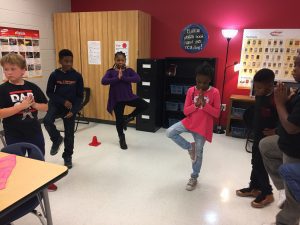Classroom Physical Activity Breaks
Print PageOverview
 Physical activity doesn’t have to be in a recess or PE setting to be effective. Classroom teachers can integrate movement-based activities to energize a group after lunch or to relax and calm a class before a test, after lunch or at the end of the day. There are many names for physical activity breaks such as brain breaks, energizers, and brain boosters. Regardless of what you call it, the goal is simple: Get kids out of their seat to be physically active throughout the school day.
Physical activity doesn’t have to be in a recess or PE setting to be effective. Classroom teachers can integrate movement-based activities to energize a group after lunch or to relax and calm a class before a test, after lunch or at the end of the day. There are many names for physical activity breaks such as brain breaks, energizers, and brain boosters. Regardless of what you call it, the goal is simple: Get kids out of their seat to be physically active throughout the school day.
Take Action
Schools and teachers looking to integrate physical activity both in and out of the classroom should start with a few initial steps and considerations before implementing a new or enhancing an existing program.
- Engage and leverage your school health team to identify key opportunities for student physical activity as well as any significant barriers to successful implementation.
- Understand your local school wellness policy and how it supports or enhances opportunities for brain breaks and classroom energizers.
- Develop your elevator pitch to describe to your different audiences why physical activity is important and how it links to academic achievement as well as other positive outcomes.
- Get your principal’s approval! A supportive principal is essential to your efforts.
- Make this activity inclusive for all abilities:
-
- Empower students to suggest and choose which activities, games and movements they find enjoyable and accessible.
- Get to know your students and find out about their abilities, limitations, and interests. Encourage them to be a part of the learning and lesson planning process.
- Demonstrate modifications of simple and complex movement skills such as jumping jacks, squats, and push-ups. For example, show students a wall push-up, a kneeling push-up, and a full push-up. Give students the opportunity to choose which option is best.
- Adapt the game or activity rules. Some simple suggestions include reducing the number of players on a team, modifying the activity area, eliminating time limits, and lowering or enlarging targets or goals.
- Try creative or team-building games where success is only possible when the whole group works together.
- Integrate various types and sizes of equipment such as tactile balls, juggling scarves, numbered spot markers, and foam noodles.
- Vary body parts used, the speed of movement, and number of repetitions to adjust for mobility limitations or low fitness students.
- Mobility adaptations: Some activities may be done from a seated position allowing mobility challenged students to participate with peers or doing similar motions with hands/arms as others are doing with feet legs.
- Sensory adaptations: Students with deafness, speech, self-management or cognitive problems may be able to participate fully in a follow the leader manner. These are very short periods of activity and done in groups of fewer than thirty so students are able to keep up to peers.
Social Emotional Health Highlights
Activities such as these help students explore…
Self-Management: Classroom Physical Activity breaks provide the perfect opportunity for students and teachers to organize their thoughts to better manage stress and control impulses. Release the wiggles with a dance or two and give students are an opportunity to check-in with their emotions and get motivated to continue working towards their goals.
Responsible Decision Making: Taking a classroom activity break can be a great way to redirect attention and antsy behavior to a fun, interactive activity or game. Sometimes all children need is a short opportunity to analyze the current situation, reflect, and responsibly choose their next action. Physical Activity breaks in the classroom provide students an opportunity to practice these skills while increasing to energize the brain.
Tips
Participate with your students in the activity. Students will be more likely to join in and have fun if they see their school community moving with them.
Keep physical activity breaks short and manageable. Shoot for 1 – 5 minute breaks at least 2-3 times per day.
Ask teachers and school administrators to share and demonstrate their favorite activities, games, and movement ideas during staff meetings throughout the school year.
Create a classroom atmosphere that embraces movement! Consider playing age and culturally appropriate music.
Integrate physical activity into academic concepts when possible.
Encourage your physical education teacher to be a movement leader and advocate.
Empower students by asking them to share and lead their own physical activity break ideas.
Add in fun equipment items such as beanbags, spot markers, yoga mats, and balance boards. Consider applying for a Game On grant!
Add physical activity breaks right into your daily schedule. Try creating a classroom physical activity calendar of events that includes a variety of ideas throughout the month. Use a classroom physical activity tracker to help your students reach 10 minutes daily!
Ask a parent volunteer create a playlist of music that complements planned movement breaks.
Ask parents to create movement break activity cards and props for teachers to use.
For more activities and ideas like this one, be sure to sign up for our news and updates. And if you like what you see, please donate to support our work creating more ways to help build a healthier future for kids.
Additional Resources
Categories: Physical Activity & Play, At School, Digital Resource